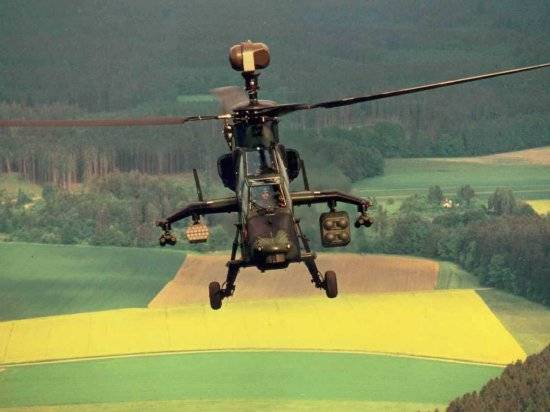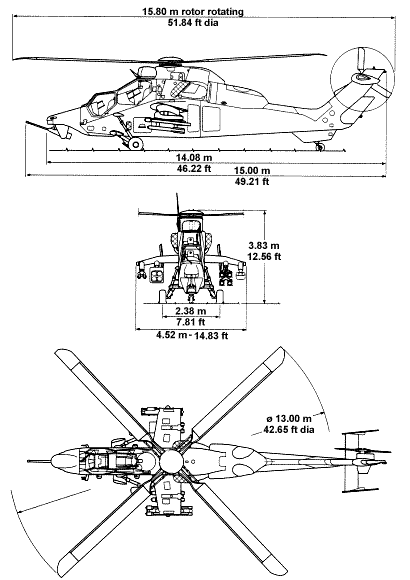|
||||||||||
|
|
||||||||||
|
||||||||||
|
|
||||||||||
 - -
 - -
|
|

|
Eurocopter Tiger, Tigre Attack Helicopter |
|
DESCRIPTION:
The Tiger owes its existence to an agreement between the German and French governments to collaborate in the development of a new advanced attack helicopter for their armies. This helicopter was to be built in different variants to meet specific anti-tank and escort missions, though most of these missions have since been merged into multi-role models. The basic design of the Tiger, or Tigre in French, is typical of contemporary attack helicopters. The slim fuselage seats two crew in a tandem, stepped cockpit. While the German model adopts the traditional placement of the gunner in the front seat and the pilot aft, the French prefer an opposite seating arrangement. The Tiger makes extensive use of composite materials both for weight reduction and to improve survivability. Armament is carried on two stub wings, and the French model is equipped with a cannon turret under the nose. The version for the German Army is the UHT anti-tank model equipped with a mast-mounted sight with infrared and TV cameras that allow the helicopter to scout and search for targets while hiding behind terrain. The Tiger UHT carries an armament of Trigat or HOT-3 missiles for anti-tank missions as well as unguided rockets or Stinger air-to-air missiles. An optional gun pod can also be fitted and a 30-mm recoilless cannon may be added in the future. Germany currently plans to purchase 80 UHT models. France, meanwhile, has split its order between two different models optimized for different missions. The French Army had originally ordered a dedicated anti-tank model called the HAC that was largely similar to the German UHT with a mast-mounted sight and armament of anti-tank missiles but no gun turret. A separate escort, fire support, and air defense version called the HAP would have a 30-mm gun turret and carry rocket pods or Mistral air-to-air missiles but not be equipped with a mast sight or anti-tank missiles. The HAP is still being purchased, although production has been slashed from 100 to 40, but the HAC was cancelled. In its place, France has instead ordered a multi-role model called the HAD equipped with the gun turret of the HAP and the Trigat anti-tank missile. A total of 80 Tigre helicopters will be purchased including 40 of the HAP escort models and 40 HAD variants. The Tiger program has been subjected to numerous delays and cost overruns that have threatened its existence from the start. Though the Tiger project began in 1984, it was cancelled just two years later due to rising costs. The program was restarted again in 1987 and the first prototype completed in 1991. It took until 2003 for the first HAP production model to fly, and the French Army received its first Tigre HAP in September of that year. In addition to France and Germany, Australia has also ordered 22 examples of the Tiger for its Army. The Australian ARH model is similar to the HAP but with an anti-tank capability provided by Hellfire II missiles. An additional export order comes from Spain which has purchased 24 Tigre HAD multi-role models. Though production was originally to total 430 airframes, current orders stand at 206. Tiger production is due to be completed in 2014.
Last modified 19 September 2009
|
|
| HISTORY: | |
| First Flight |
(PT-1) 29 April 1991 (Tigre HAP) March 2003 (Tiger ARH) February 2004 |
|
Service Entry
|
(Tigre HAP) 2005 (?) (Tiger ARH) 2007 |
| CREW: |
two: pilot, gunner
|
|
ESTIMATED COST:
|
(Tiger UHT) $40 million [2002$] (Tigre HAP) $37 million [2002$] (Tigre HAD) $46 million [2002$] (Tiger ARH) $36 million [2002$] |
| AIRFOIL SECTIONS: | |
| Rotor Blade Root | unknown |
|
Rotor Blade Tip
|
unknown
|
| DIMENSIONS: | |
| Length |
51.79 ft (15.80 m) with rotors turning (UHT) 46.17 ft (14.08 m) ignoring rotors (HAP) 49.21 ft (15.00 m) ignoring rotors |
| Rotor Diameter | 42.65 ft (13.00 m) |
| Wingspan | 14.83 ft (4.52 m) |
| Height |
12.5 ft (3.81 m) to top of rotor head 14.17 ft (4.32 m) to top of tail rotor 17.06 ft (5.20 m) to top of mast-mounted sight |
|
Rotor Disk Area
|
1,428.4 ft² (132.73 m²)
|
| WEIGHTS: | |
| Empty | 7,275 lb (3,300 kg) |
| Normal Takeoff | 12,785 lb (5,800 kg) |
| Max Takeoff | 13,230 lb (6,000 kg) |
| Fuel Capacity |
internal: 2,380 lb (1,080 kg) external: 1,090 lb (495 kg) |
|
Max Payload
|
(HAP) 3,970 lb (1,800 kg) (UHT) 3,635 lb (1,650 kg) |
| PROPULSION: | |
| Powerplant | two MTU/ Turbomeca/ Rolls-Royce MTR 390 turboshafts |
| Thrust |
2,570 shp (1,916 kW)
|
| PERFORMANCE: | |
| Max Level Speed |
at altitude : 200 mph (320 km/h) [clean] 175 mph (280 km/h) [armed] at sea level: unknown cruise speed: 145 mph (230 km/h) |
| Maximum Climb Rate |
(UHT) 2,105 ft (640 m) / min (HAP) 2,265 ft (690 m) / min |
| Service Ceiling | 13,125 ft (4,000 m) |
|
Hover Ceiling (out of ground effect) |
11,480 ft (3,500 m) |
| Range |
typical: 430 nm (800 km) ferry: 700 nm (1,300 km) |
| Endurance | 3 hr 25 min |
| g-Limits |
unknown
|
| ARMAMENT: | |
| Gun | (HAP/HAD/ARH) one GIAT AM-30781 30-mm cannon (150-450 rds) |
| Stations | 2 stub-wings with 4 hardpoints |
| Air-to-Air Missile | up to four Matra Mistral or Stinger |
| Air-to-Surface Missile | up to eight Trigat, HOT-2, HOT-3, or TOW-2 anti-tank |
| Bomb | none |
| Other |
up to two 68-mm or 70-mm rocket pods, 12.7-mm gun pod, 20-mm gun pod
|
| KNOWN VARIANTS: | |
| PT-1 | Aerodynamic prototype |
| PT-2 | HAP prototype |
| PT-3 | UHU prototype |
| PT-4 | Full HAP prototype with a complete avionics and weapons fit |
| PT-5 | Full UHU prototype with a complete avionics and weapons fit |
| PT-6 | Full HAC prototype with a complete avionics and weapons fit |
| EC 665 | Eurocopter designation for the Tiger/Tigre helicopter family |
| PAH-2 | Panzerabwehrhubschrauber 2, German designation for the Tiger, original configuration was to be a dedicated anti-tank model carrying up to eight HOT-2 or Trigat missiles but this was cancelled in favor of the multi-role UHT design |
| UHT or UHU | Unterstutzungshubschrauber, German multi-role anti-tank and support model equipped with a mast-mounted sight and anti-tank missiles, other armaments include 70-mm rocket pods, Stinger self-defense air-to-air missiles, and an optional 12.7-mm gun pod; 212 originally planned but now only 80 to be built |
| HAP or HCP | Helicoptere d'Appui et de Protection (or Helicopter for Close Protection), French escort and fire control model featuring a 30-mm gun turret and usually armed with 68-mm rocket pods or Mistral air-to-air missiles; 100 originally planned but now only 40 to be built |
| HAC | Helicoptere Anti-Char, French anti-tank model similar to the German UHT; 115 originally planned but cancelled in favor of the HAD |
| HAD | Helicoptere Appui Destruction, French multi-role attack helicopter that merges many of the features of the HAP and HAC into a single model, based on the HAP but adds the anti-tank capability of the HAC and also includes uprated engines as well as improved ballistic protection; 40 to be built for France and 24 for Spain (18 new build, 6 refitted from HAP) |
| ARH |
Armed Reconnaissance Helicopter model for Australia based on the HAP but with upgraded engines and a laser
designator for its primary armament of Hellfire II anti-tank missiles; 22 to be built
|
|
KNOWN COMBAT RECORD:
|
none
|
|
KNOWN OPERATORS:
|
Australia (Royal Australian Army Aviation) France, Aviation Légère de l'Armée de Terre (French Army Light Aviation) Germany, Deutsche Heeresfliegertruppe (German Army Air Corps) Spain, Fuerzas Aeromóviles del Ejército de Tierra (Spanish Army Airmobile Force) |
|
3-VIEW SCHEMATIC:

|
|
SOURCES:
|
|


|
Aircraft | Design | Ask Us | Shop | Search |

|
|
| About Us | Contact Us | Copyright © 1997-2023 | |||
|
|
|||